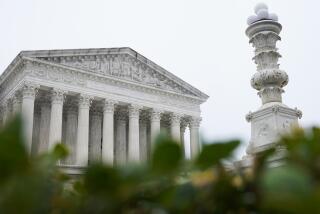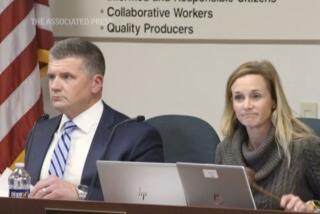Pennsylvania hit by more jobless claims than any other U.S. state

- Share via
PITTSBURGH — It is a dreary roll call: The Wyndham Hotel in the historic battlefield town of Gettysburg filed papers to lay off 78 employees; the Altimate Air Trampoline Park in North Versailles, 23; a newsstand at Philadelphia International Airport, 13.
Pennsylvania, the nation’s fifth-most populous state, has recorded 2,751 cases of coronavirus and 34 deaths as of noon Saturday.
This past week, it reported the largest number of new unemployment claims of any state: 378,908, or 25 times as many as the week before.
“We soon will be talking about even bigger numbers,” warned Christopher Briem, a regional economist at the University of Pittsburgh Center for Social and Urban Research. “Some small and medium-size employers that are trying to keep people on the payroll won’t be able to.”
A state that only weeks ago was an education and energy powerhouse is reeling under the pressure of the COVID-19 pandemic. It may stand out as a joblessness leader because other states’ reporting is lagging, or because the filing procedure in the state is less cumbersome. But no one here doubts that the employment picture will do anything but darken.
Indeed, it already is dark in multiple sectors in the two major metropolitan areas of Philadelphia and Pittsburgh, and in the many small cities and towns 300 miles between them.
“Philadelphia and Pittsburgh are two dense areas and that doesn’t help,“ said Timothy J. Bartik, senior economist at the Upjohn Institute for Employment Research in Kalamazoo, Mich. “Both cities get convention business, both have major airports and both have major universities. Energy has been affected, and that’s big in Pennsylvania.”
The city of Pittsburgh is offering rent, mortgage and utility-payment assistance for those who have lost jobs or suffered cuts in their work hours and is extending credit up to $15,000 at zero interest for as many as 30 small businesses.
“Right now we are trying to help those who have lost their jobs or are underemployed or who have businesses that cannot make it another month,” said Mayor William M. Peduto. “We recognize that science tells us that April will be worse than March. We’re trying to minimize the amount of deaths and then do our best as a city not to go bankrupt before the end of the year.”
The ripple effects of travel restrictions and school closings have become a tsunami.
Doug Anderson’s father converted a panel truck into a bus with benches in 1937 to convey children to the one-room schoolhouse where his future wife was the sole teacher. Until recently the Anderson family was operating school buses serving four districts 80 miles north of Pittsburgh and had 40 motor coaches it used to take tourists around the country. With the tourism business in free fall and area schools closed at least until April 9 — and probably longer, perhaps for the remainder of the academic year — he laid off 270 full- and part-time employees. Half the six employees who remain are family members.
“Business is zero,” he said after hanging up with one of the managers he had to lay off. “It was hard to say goodbye to people. Some of my employees have been with its for more than 50 years. It’s a killer.”
It was no easier for Jim Fris, president of PJW Group, which ordinarily operates 15 P.J. Whelihan’s restaurants in communities in the eastern part of the state such as Allentown, Bethlehem and Newtown Square. Now outlets in venues such as Malvern and Lancaster are closed and the remaining restaurants are offering take-out meals — five chicken wings in garlic parmigiana sauce for $6.99, complete crab cake dinner for $18.79 — delivered straight to customers’ cars curbside.
The toll: Sales down 90%, 800 workers furloughed.
“We will try to hang in there,” said Fris, “but we are not going to stay open to lose money.”
P.J. Whelihan’s is only one of the disaster stories in Pennsylvania, where 582,000 people work in restaurant or food-service businesses.
“We’ve been hit hard,” said John Longstreet, a former chief executive of the Quaker State & Lube restaurant chain who is now president of the Pennsylvania Restaurant and Lodging Assn. “Even with the small rise in takeout, there’s still not people moving around. We could be looking at 80 or 90% of our workers laid off or furloughed.”
At the same time, the lodging industry is in full retreat, with last year’s 60% occupancy rate now hovering in the teens or upper single digits. As many as 70% of the lodging workforce has been laid off or furloughed.
There is wreckage in the state’s cultural sector as well.
“Everybody’s focusing on the airlines and hotels, but in effect the arts are the entertainment business and we are hurting badly,” said Kevin McMahon, resident of the Pittsburgh Cultural Trust, which plays host to more than 2,000 events annually in the region and is facing a deficit for the first time in its three-decade history. “Our fundamental business is to bring people together for mass gatherings. We are completely shut down. All the people involved in the actual staging of things have no work.
“Even in 2008 we had to be more careful,” he continued, “but our operating business weren’t shut down.”
Employers across the state are struggling to decide what to do.
“I’ve been spending a lot of time with clients trying to figure out how they should proceed,” said Jonathan S. Krause, an employment lawyer with the Philadelphia firm of Klehr Harrison Harvey Branzburg. “Some are past the point of worry. Their businesses don’t functionally exist anymore. Others are worried about the disruptions in their supply chains and they’re tying to figure out how to proceed, and whether they can retain their workers when their revenue has essentially disappeared overnight.“
Already groups here are offering proposals to ease the economic pain, some of them controversial.
The conservative Freedom Foundation is asking Gov. Tom Wolf to call for a three-month suspension of dues deductions by “wealthy government unions” to put as much as $63 million in the pockets of government workers. “People need to pay rent, put food on the table and gas in their car,” said Tom McCabe, the foundation’s president. The second-term Democratic governor, who received more than $10 million in PAC money from government unions, is not likely to do that.
But help is on the way, in the form of federal stimulus money, and local leaders believe more may come before long. Pennsylvania is ready.
“It is a nightmare to handle all the regulatory and bureaucratic functions to get the money moving,” said Thomas J. Foley, a former Pennsylvania secretary of labor and industry. “The good news is that the state is ready to process these claims, once the money comes. They knew it was coming.”
It is not as if Pennsylvania has not suffered huge job losses before. The Pittsburgh area, for example, lost half its manufacturing jobs in the first half of the 1980s alone. Unemployment peaked in Allegheny County at about 18%, with nearby Beaver County spiking beyond 20% — numbers that economists believe may be reached here again before long.
But there is a fundamental difference between jobs lost in that period and jobs lost this spring. In the 1980s, Pittsburgh stood apart as one of the great venues for economic distress and employment scarcity; today the distress and unemployment run coast to coast and in virtually every sector. The option of moving to an area of job growth — one taken by local workers who fled to North Carolina, Texas and the Washington, D.C., region in the 1980s — is not available when the distress is nationwide.
“People out of work here this time,” said the University of Pittsburgh’s Briem, “are trapped the way everyone else is.”
More to Read
Sign up for Essential California
The most important California stories and recommendations in your inbox every morning.
You may occasionally receive promotional content from the Los Angeles Times.










